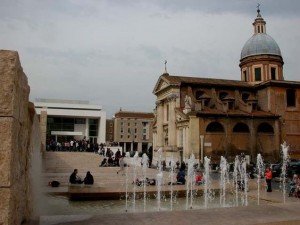Port of Ripetta
River port of some importance even at the time of St. Camillus since many merchant ships docked there coming along the Tiber from Umbria, North of Lazio and Sabina with indispensable products for the supply of the Urbe. One of the “historic sites of the disappeared Rome” whose memory is assigned to a square or a street, created in the vicinity of the real site that no longer exists, in the vicinity of the Ara Pacis, at the entrance of Ponte Cavour.
The presence of St. Camillus
At the end of 1571, when he’s still a young scapegrace, Camillus is convalescing at the St. James Hospital and works as a servant to repay the hospitality. However, for his constant spats with the other servants, but also because, prone to playing cards, he often leaves the service of the infirm to go play with boatmen at the Port of Ripetta, and for this reason he’s fired. The Hospital’s Master of the House turns him out, in fact, following the discovery of a deck of cards under the pillow of his bed. After a few years the presence of Camillus in the small river port is quite different: embarking from there the poor lepers, expelled from the town, Camillus tries to convince them with his prayers, not to climb on boats, sparking the wrath of the man who administers the departures of those outcasts. Wanting to appease his anger with humility and prayer, Camillus kneels in front of him asking to leave there at least the most broken and emaciated ones, that almost can’t hold up. Which he finally obtains, while continuing to mourn the loss of the others, trying to console them aloud as he sees them sadly leave.
What remains
 There is no physical evidence of the passage of our Saint, unless written testimonies that describe him as he plays cards with the boatmen of the port when he’s still a young scapegrace and convalescent at the St. James Hospital and he serves as clerk to repay the hospitality (1571). In other texts, however, far more edifying, we see him perform acts of charity and assistance to the St. James Hospital for the Incurables plague victims who were transported away by barge from the small port.
There is no physical evidence of the passage of our Saint, unless written testimonies that describe him as he plays cards with the boatmen of the port when he’s still a young scapegrace and convalescent at the St. James Hospital and he serves as clerk to repay the hospitality (1571). In other texts, however, far more edifying, we see him perform acts of charity and assistance to the St. James Hospital for the Incurables plague victims who were transported away by barge from the small port.
To see
Church of St. Roch: in the same square of the Port of Ripetta, it was built on the initiative of the Confraternity of St. Roch, formed by the boatmen and dockers, on a former abandoned church dedicated to St. Martin, until recently entrusted to Dalmatians hermits. Consecrated in 1502, a few years later there annexed arose the hospital where the patients of various Universities of artisans congregated to the Company of St. Roch were hospitalized. The church is not that of the time of St. Camillus, but a new one, the construction of which began in 1657. The chapel near the main altar, where there is the carved image of the Virgin Mary (perhaps that worshiped by St. Camillus), realized in 1665, it was decorated with stones and marbles and designed by Nicholas Menghino; the paintings of the dome are by the son of Antonio Carosi Genovese. On the main altar, commissioned by Cardinal Dean Francesco Barberini, a painting represents our Lord and S. Roch with the lepers, work by Giacinto Brandi.
Nearby
Ara Pacis: the Ara Pacis Augustae is an altar (Altar of Augustan Peace) dedicated by Augustus in 9 BC to the Peace, intended as a Roman goddess, in the Augustan age, and placed in an area of Campo Marzio consecrated to the celebration of victories. It represents one of the most important examples of Augustan art and is intended to symbolize peace and prosperity achieved as a result of the Pax Romana.
 From Termini Station take metro line A, get off at Spagna and continue on foot for 950m.
From Termini Station take metro line A, get off at Spagna and continue on foot for 950m.
From Tiburtina Station take metro line B, get off at Termini and take metro A, get off at Spagna and continue on foot for 95m.
Bus numbers 186, 628, 81, 87, 492, 70, 87, C3, and get off at the Ripetta stop.















Camillians on Facebook
Camillians on Twitter
Camillians on Instagram